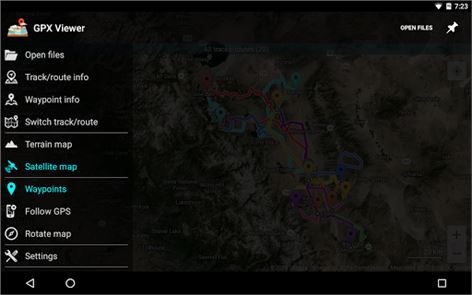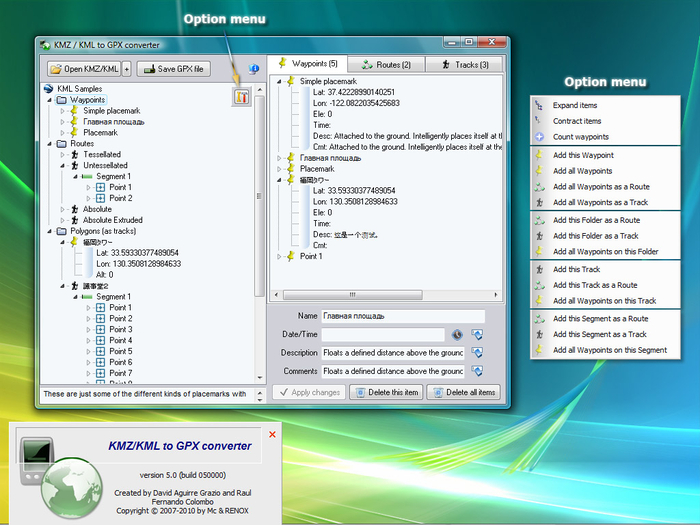
The muir trail track you found looks a lot like somebody took mytopo and drew a line following the published map trails, but those can be off by quite a bit. Only thing is the fat line width you can't control with GPX, but if you zoom in it gets better. Here's my actual entire JMT data from a freshly merged GPX with only the relevant location content from 22 days (GPX_Editor has great features to clean up those files). My GPX is stripped down from the originals, no time, no elevation data, so they are quite compact. Clearly, there's the problem why KML didn't work for me, because whatever preferences I used in GPS Babel (default), it was adding a ton of fluff. Waypoints are generally single unrelated points, while tracks consist of a route or collection of related points with a start and end point. gpx file stores points as waypoints or tracks. Thanks for this - I tried GPSBabel to convert my GPX to KML - my file in GPX was 1299kb, while in KML it exported to 18,200kb. Usage The tool converts the point data in a. Maximum number of total document-wide featuresđ,000 Maximum fetched file size (raw KML, raw GeoRSS, or compressed KMZ)ēMB Google has limits on the size of KML file that can be displayed. Gmap4 converts GPX files to KML files before displaying the map (required by the Google Maps API) Then click on the 'File Name' button and navigate to the folder in which you want. For the 'Output', select File and use the down-arrow at the right of the Format field to fiind 'GPX XML'. For our purposes, the Translation Options will have 'Waypoints' checked. If the same track is in a GPX file and a KML file, the GPX file will always be bigger. Click on the 'File Name' button and navigate to the. By moving the mouse over the points of the track opens a tool tip with the coordinates, the distance to that. For examples: Search the Trip Report forum at for 'Gmap4'. then click on the button 'process File', will be automatically processed and displayed on the map, it also creates the chart with the altitude and speed. Gmap4 has a liquid design and will look decent in an iframe down to 400px by 400px.
DOES GPX VIEWER USE KML FREE
Your users could include a 100% free interactive map with their GPS track and waypoints along with the rest of their trip report. Check out the 'Examples' button and the Quick Start section of the 'Help' file.įinally, if you run a website where people file trip reports you could consider allowing Gmap4 to run in an iframe.

Here is the general recipe for building a URL to display a data file with Gmap4 (do not include the quotes, these are not real links):įor data files showing locations in the USA or Canada:īelow is a link to the Gmap4 homepage. You will find hand-holding-step-by-step instructions in the Gmap4 Help file. The easiest/fastest way to place files online is via Google Sites (free). You do need to place your GPX, KML, KMZ and TPO files online before they can be displayed by Gmap4. In addition to surfing topographic maps, you can also view data from the following types of files: GPX, KML, KMZ, TPO & Google MyMap files. There is nothing to buy, nothing to download, nothing to install. It includes detailed topographic maps (courtesy of for the USA and Canada. tOnFeatureClickListener(new KmlLayer.I am the author of Gmap4 which is a 100% free no-ads full-screen enhanced Google Map viewer. Set a listener for geometry clicked events. A Context object, which is required to open a local resource.A local resource file containing the KML data.A GoogleMap object where the layer is to be rendered.To import and render a KML dataset from a local resource, you need: And if it does not, use Google Earth, or one of countless free KML/GPX file converters to convert the KML to GPX - for example KML2GPX or GPSVisualizer Once done, you can import the GPX file on the page Courses of Garmin Connect Web (see the small link Import at the bottom right of the white window), or by opening it directly with the Garmin. To add a data layer to the map, first create an instance of the What is GPXSee GPXSee is a GPS log file viewer and analyzer that supports all common GPS log file formats. GetProperties() on any Placemark, GroundOverlay, Document or To access properties in a KML object, call To add and remove your KML data to and from the map, call There are some aspects of KML that do not work well on 2D screens and some limitations to what web browser clients can support.


KML is now supported in a number of two-dimensional web browser clients, including Map Viewer and Map Viewer Classic. Using this utility, youĬan convert KML objects into geographical shapes and render them as a layer on KML was originally created to view features in three-dimensional Earth browsers such as ArcGIS Earth.


 0 kommentar(er)
0 kommentar(er)
